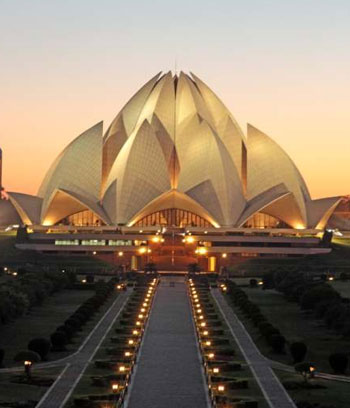
Delhi Package
Delhi, the capital of the world’s largest democracy, is not one city—but seven cities, says the tradition. From the time of the Pandavas, the victorious brothers in the Mahabharata war, who made it their capital around 1500 B.C.- the city was then known as Indraprastha. The city has been rebuilt seven times, in seven different ages.
The seventh reconstruction had been carried out by Emperor Shah Jahan (the builder of the Taj Mahal). He had named it Shahjahanabad, after completing its work in 1648. Posterity, however, remembers his city as Old Delhi.
Just as Delhi and its surrounding areas are dotted with monuments, so also the past of Delhi is dotted with numerous memorable events. Battles have soaked its earth with the blood of many a race; shouts of triumph and cries of defeat have rent its skies umpteen times. Its dust contains the vestiges of innumerable ancient monuments, some ravaged by time and some by hordes of invaders who plundered them time and again.
How did this ancient Indraprastha assume the name, Delhi? A legend says that it owes the name to a legendary king, Dilli. But an elaborately organized story gives a different account. Delhi is situated exactly on the hood of the mythical serpent, Vasuki, who supports the earth. A certain king desired to check its veracity as described in some ancient holy works. He got a long iron pole made and sunk one end of it till it had touched the serpent’s hood. It pierced through the hood and transfixed it.
Near Qutub Minar can be seen the remains of a citadel called Lal Kot, supposed to have been built by Rajput king Anangpal. From his dynasty, the region passed on to the Chauhans—Prithviraj, who was the last Hindu king of Delhi.
Prithviraj and Samyukta, the daughter of Jaichandra, the king of Kannauj, had met and set their hearts on each other despite a great difference in their ages. Jaichandra hated Prithviraj. He arranged for his daughter’s ‘swayamvara’—a ceremony in ancient India where a princess exercised her freedom to
While Ghori was thus sulking under humiliation, he joined hands with Jaichandra and in a fiercely fought battle defeated and killed Prithviraj. Samyukta set herself ablaze and died; so did her maids. This was in 1192. Jayachandran, of course, was betrayed by his ally. The very next year Ghori killed him and captured his kingdom.
After Ghori, one of his viceroys, Qutub-ud-din, ruled Delhi. He was originally a slave. His dynasty became known as the Slave Dynasty (1206-1290).
A remarkable lady who ruled the Delhi sultanate for four years belonged to this dynasty. She was Raziya. Her father, Iltutmish, while dying, declared her as his successor, instead of his son, for he knew her ability.
Indeed, she proved kind and capable. But the nobles disliked being ruled by a woman. They revolted under the leadership of Altuniya. In a dramatic bid, Raziya tried to win Altuniya’s love and succeeded. She married him, only to fall, along with him, to the swords of the adversaries in 1240.
The Slave Dynasty was put to an end by Jalal-ud-din Firuz Shah, whose father had been executed by Kaikubad, the last of the Slave sultans. Jalal-ud-din accomplished the feat by murdering Kaikubad. The Dynasty he founded is known as the Khilji Dynasty (1290-1320).
The last of the Khiljis was beheaded by Ghiyas-ud-din Tughlaq who began the Tughlaq Dynasty (1320-1413).
The fall of this dynasty was hastened by the invasion of the cruel Timur (Tamerlane) of Samarkand. Sultan Muhammad Tughlaq tried to check his advance but in vain. Timur massacred 1,00,000 adult males, his prisoners, in cold blood, and then stayed in Delhi for a fortnight letting his soldiers plunder the city, and returned home becoming the richest man of the time.
After the death of the last Tughlaq, the Sayyids and the Lodis ruled Delhi from 1413 to 1528. Then came Babur, a descendant of Timur, the founder of the Mughal Dynasty.
One of Nadir’s soldiers who had gloated over his master’s booty became chief in Afghanistan after Nadir’s assassination. He was never tired of leading expeditions to India. In 1757 he struck Delhi and conducted pillage that was as thorough as his master’s.
A famous saying is attributed to Saint Nizamuddin. When Sultan Ghias-ud-din was entering Delhi after an expedition to Bengal, the saint said, Hanuz Delhi dur use meaning, “Delhi is still far!”
Soon a huge pavilion, constructed to receive the Sultan, collapsed on his head and killed him. Delhi remained far for him. And Delhi remained far for many an aspiring invader or prince. The real Delhi —the symbol of the highest mundane glory, perhaps slipped through the fingers of many who even arrived there!
In 1858, the government of India passed on from the East India Company to the British Crown. Calcutta became India’s capital. Delhi’s lost glory was restored to it in 1911 when King George V held a Durbar here and announced that Delhi was to be the capital of India thereafter.
Throughout its chequered history, Delhi reached 15 August 1947— when India became independent. It is on the rise ever since.
The two worlds of the city, the Old and the New form a grand synthesis, as natural as the coexistence of night and day, one enriched by the other’s splendors.
We shall now tell you about the monuments and places of interest. We could very well draw for you a sequence, placing the spots in order as you should see them one after the other. But our survey shows that any such order is unrealistic, for, much will depend on the time available to you, where you stay, and your interest. Hence we put them in alphabetical order.
Get answers and advices from Professional Tour Consultants.

Contact No.
+91-8587983942

Our Email
info@champarantravels.com
